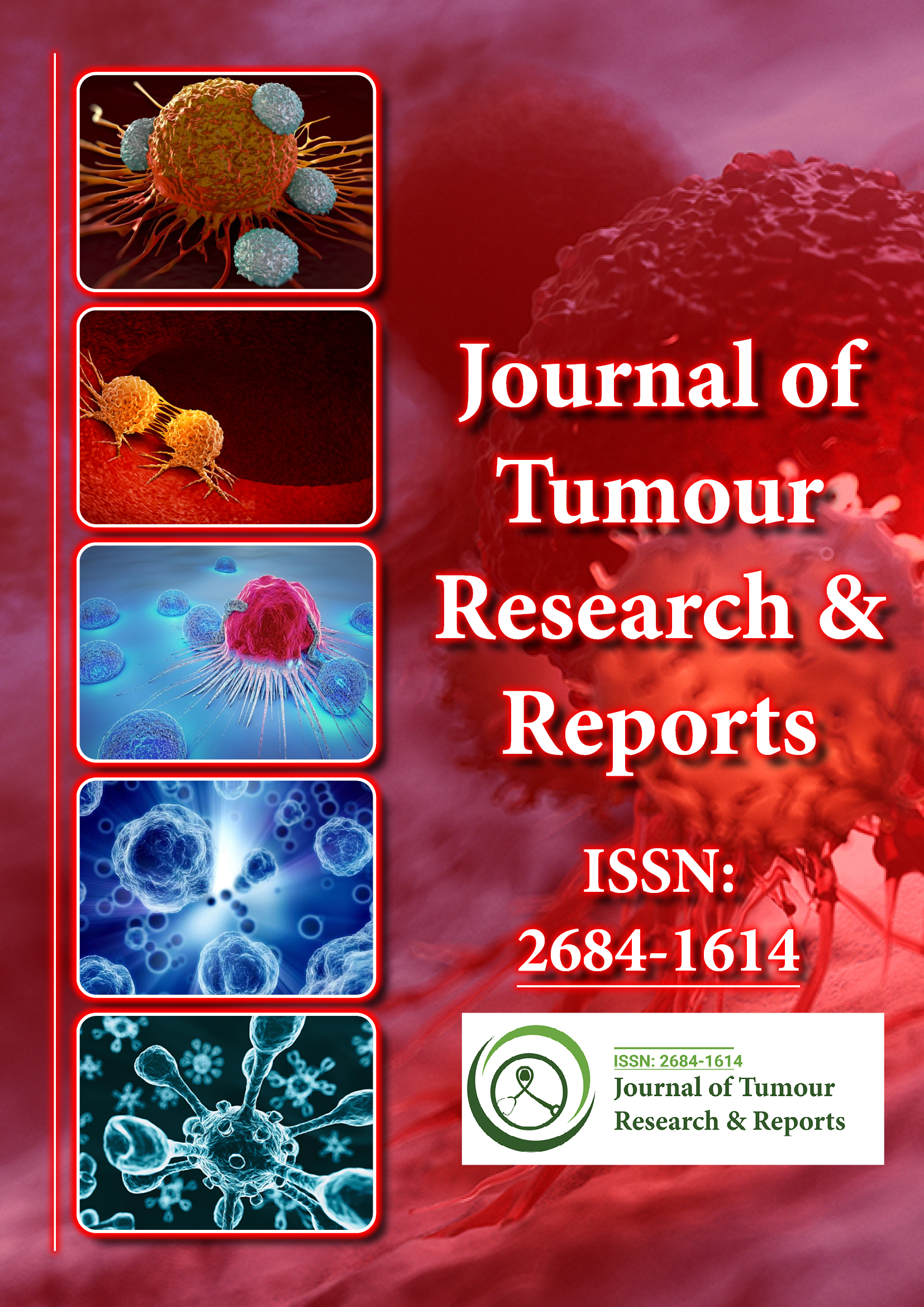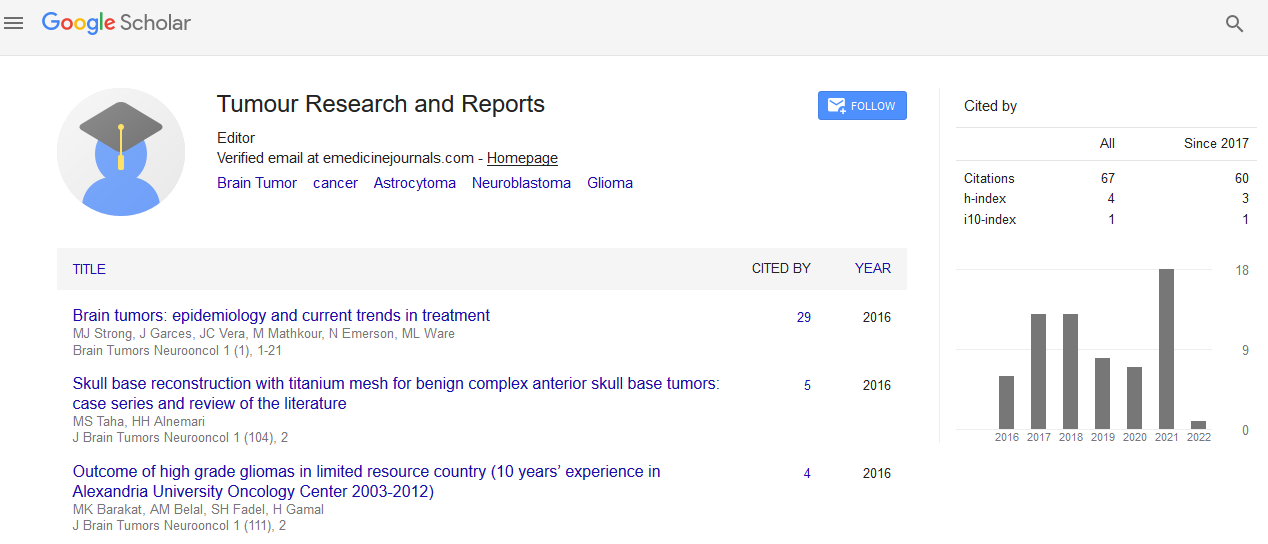Indexed In
- RefSeek
- Hamdard University
- EBSCO A-Z
- Google Scholar
Useful Links
Share This Page
Journal Flyer

Open Access Journals
- Agri and Aquaculture
- Biochemistry
- Bioinformatics & Systems Biology
- Business & Management
- Chemistry
- Clinical Sciences
- Engineering
- Food & Nutrition
- General Science
- Genetics & Molecular Biology
- Immunology & Microbiology
- Medical Sciences
- Neuroscience & Psychology
- Nursing & Health Care
- Pharmaceutical Sciences
Opinion Article - (2025) Volume 10, Issue 1
Cancer Stem Cells in Glioblastoma: Drivers of Resistance and Recurrence
Nathaniel Brooks*Received: 03-Mar-2025, Manuscript No. JTRR-25-29018; Editor assigned: 05-Mar-2025, Pre QC No. JTRR-25-29018 (PQ); Reviewed: 19-Mar-2025, QC No. JTRR-25-29018; Revised: 26-Mar-2025, Manuscript No. JTRR-25-29018 (R); Published: 02-Apr-2025, DOI: 10.35248/2684-1614.25.10.249
Description
Glioblastoma Multiforme (GBM) is the most aggressive primary brain tumor in adults, characterized by rapid progression, extensive invasion into surrounding brain tissue, and poor prognosis despite aggressive multimodal treatment. Standard therapy consisting of maximal surgical resection followed by radiotherapy and temozolomide chemotherapy provides only modest improvement in survival, with a median overall survival of approximately 15 months. A growing body of research has implicated a subpopulation of cells known as Cancer Stem Cells (CSCs) in the initiation, propagation, and therapeutic resistance of GBM. Understanding the biology of these CSCs is key to developing more effective and durable treatment strategies.
Cancer stem cells, also referred to as Glioma Stem Cells (GSCs) in the context of GBM, are a small subset of tumor cells with the ability to self-renew, differentiate, and reinitiate tumor growth. These cells share properties with normal neural stem cells but exhibit dysregulated growth and differentiation pathways. GSCs are highly tumorigenic and capable of recreating the heterogeneity of the original tumor when implanted into immunodeficient mice, making them central to disease maintenance and recurrence.
One of the defining features of GSCs is their resistance to conventional therapies. Radiation and chemotherapy primarily target rapidly dividing cells, yet GSCs can exist in a relatively quiescent state, allowing them to evade such treatments. Furthermore, GSCs possess enhanced DNA repair mechanisms, increased expression of drug efflux transporters, and heightened antioxidant defenses, all of which contribute to treatment resistance. These properties allow GSCs to survive initial therapies and repopulate the tumor, leading to inevitable recurrence.
Molecular profiling has revealed several key signaling pathways involved in the maintenance of GSCs, including the Notch, Hedgehog, and Wnt/β-catenin pathways. These developmental pathways, which regulate stem cell renewal and differentiation during embryogenesis, become aberrantly activated in GSCs, promoting their survival and proliferation. For example, Notch signaling is known to enhance GSC maintenance and radioresistance. Targeting these pathways with small molecule inhibitors has shown promising results in preclinical studies, although clinical translation remains challenging due to pathway redundancy and toxicity in normal tissues.
Another critical aspect of GSC biology is the influence of the Tumor Microenvironment (TME). GSCs are often located in perivascular and hypoxic niches that provide supportive cues for stemness and survival. In the perivascular niche, endothelial cells secrete factors such as nitric oxide and VEGF that reinforce GSC characteristics. Hypoxia, a common feature of GBM due to its rapid growth and insufficient vascularization, stabilizes Hypoxia-Inducible Factors (HIFs), which in turn promote the expression of stem cell markers and therapy resistance genes. Targeting the interactions between GSCs and their microenvironment may be a promising therapeutic strategy to overcome resistance.
Markers commonly used to identify GSCs include CD133 (prominin-1), Nestin, and SOX2. CD133-positive cells isolated from GBM samples have been shown to possess stem-like properties and high tumorigenic potential. However, CD133 expression is not universal across all GSCs, and reliance on a single marker has proven insufficient for accurate identification. A combination of surface markers and functional assays is often necessary to enrich for true GSC populations.
Emerging therapeutic approaches aim to target GSCs directly or sensitize them to existing treatments. For instance, inhibition of Bmi-1, a polycomb group protein that regulates self-renewal, has been shown to reduce GSC proliferation and enhance radiosensitivity. Similarly, targeting metabolic pathways unique to GSCs, such as mitochondrial oxidative phosphorylation or lipid metabolism, has revealed vulnerabilities that can be exploited therapeutically.
Immunotherapeutic strategies are also being investigated in the context of GSCs. These cells exhibit low expression of Major Histocompatibility Complex (MHC) molecules and costimulatory markers, allowing them to escape immune detection. However, Chimeric Antigen Receptor (CAR) T-cell therapies directed against GSC-associated antigens such as IL13Rα2, EGFRvIII, and CD133 have shown early promise in preclinical and clinical studies. The heterogeneity of antigen expression and potential for antigen loss remain significant hurdles, emphasizing the need for multi-targeted or adaptable approaches.
Another innovative strategy is the use of differentiation therapy, where agents are employed to force GSCs into a more differentiated, therapy-sensitive state. Bone Morphogenetic Proteins (BMPs), for example, induce differentiation of GSCs and reduce their tumorigenicity. Combining differentiation agents with cytotoxic therapies may increase treatment efficacy and reduce recurrence rates.
Citation: Brooks N (2025). Cancer Stem Cells in Glioblastoma: Drivers of Resistance and Recurrence. J Tum Res Reports. 10:249.
Copyright: © 2025 Brooks N. This is an open-access article distributed under the terms of the Creative Commons Attribution License, which permits unrestricted use, distribution, and reproduction in any medium, provided the original author and source are credited.

